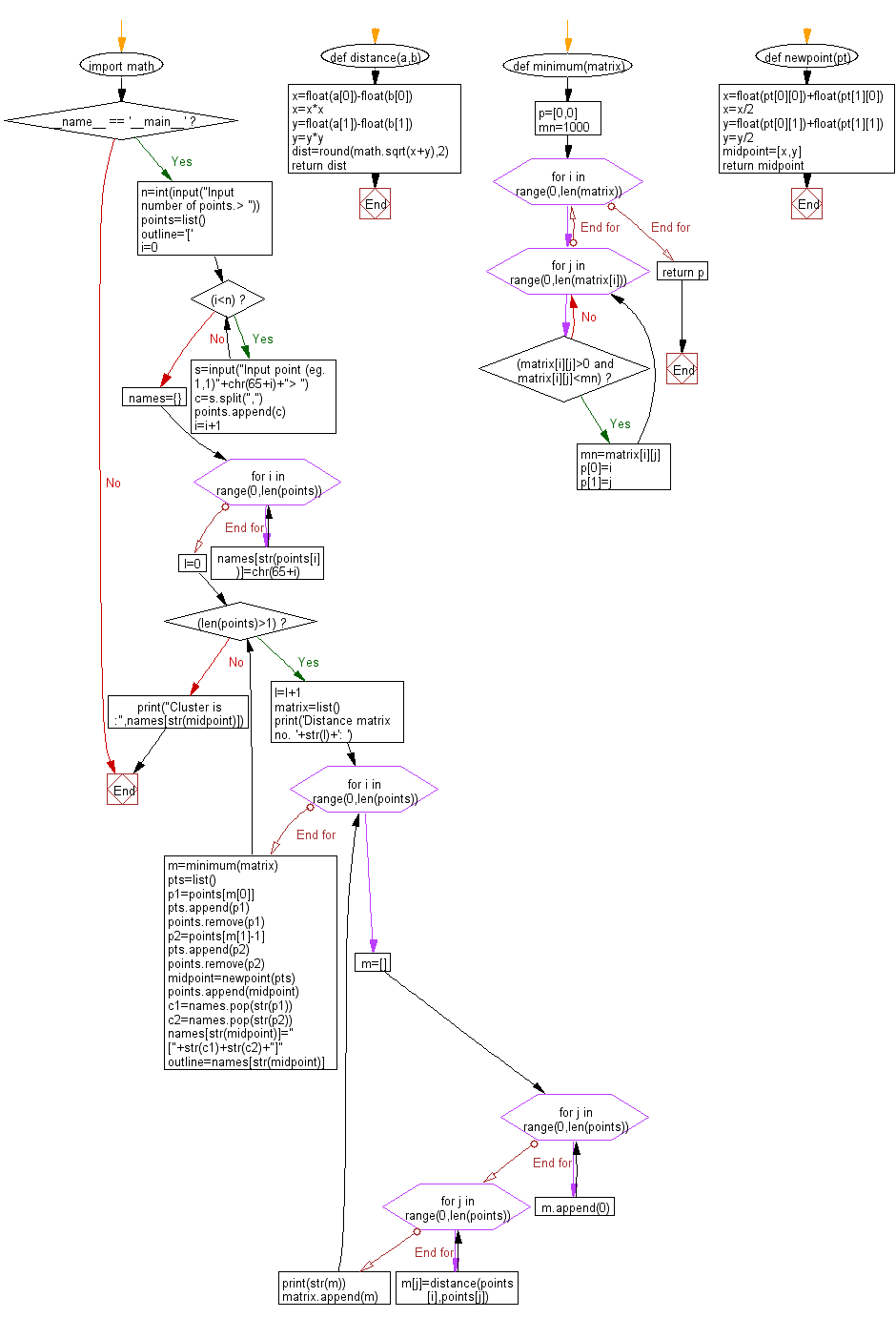Python Math: Calculate clusters using Hierarchical Clustering method
Python Math: Exercise-75 with Solution
Write a Python program to calculate clusters using Hierarchical Clustering method.
Sample Solution:-
Python Code:
#https://gist.github.com/vineetrok/1391954
import math
def distance(a,b):
x=float(a[0])-float(b[0])
x=x*x
y=float(a[1])-float(b[1])
y=y*y
dist=round(math.sqrt(x+y),2)
return dist
def minimum(matrix):
p=[0,0]
mn=1000
for i in range(0,len(matrix)):
for j in range(0,len(matrix[i])):
if (matrix[i][j]>0 and matrix[i][j]<mn):
mn=matrix[i][j]
p[0]=i
p[1]=j
return p
def newpoint(pt):
x=float(pt[0][0])+float(pt[1][0])
x=x/2
y=float(pt[0][1])+float(pt[1][1])
y=y/2
midpoint=[x,y]
return midpoint
if __name__ == '__main__':
n=int(input("Input number of points.> "))
points=list()
outline='['
i=0
while(i<n):
s=input("Input point (eg. 1,1)"+chr(65+i)+"> ")
c=s.split(",")
points.append(c)
i=i+1
names={}
for i in range(0,len(points)):
names[str(points[i])]=chr(65+i)
l=0
while(len(points)>1):
l=l+1
matrix=list()
print('Distance matrix no. '+str(l)+': ')
for i in range(0,len(points)):
m=[]
for j in range(0,len(points)):
m.append(0)
for j in range(0,len(points)):
m[j]=distance(points[i],points[j])
print(str(m))
matrix.append(m)
m=minimum(matrix)
pts=list()
p1=points[m[0]]
pts.append(p1)
points.remove(p1)
p2=points[m[1]-1]
pts.append(p2)
points.remove(p2)
midpoint=newpoint(pts)
points.append(midpoint)
c1=names.pop(str(p1))
c2=names.pop(str(p2))
names[str(midpoint)]="["+str(c1)+str(c2)+"]"
outline=names[str(midpoint)]
print("Cluster is :",names[str(midpoint)])
Sample Output:
Input number of points.> 2 Input point (eg. 1,1)A> 1,2 Input point (eg. 1,1)B> 3,4 Distance matrix no.1: [0.0, 2.83] [2.83, 0.0] Cluster is : [AB]
Flowchart:

Visualize Python code execution:
The following tool visualize what the computer is doing step-by-step as it executes the said program:
Python Code Editor:
Have another way to solve this solution? Contribute your code (and comments) through Disqus.
Previous: Write a Python program to select a random date in the current year.
Next: Write a Python program to implement Euclidean Algorithm to compute the greatest common divisor (gcd).
What is the difficulty level of this exercise?
Test your Programming skills with w3resource's quiz.
Python: Tips of the Day
Find current directory and file's directory:
To get the full path to the directory a Python file is contained in, write this in that file:
import os dir_path = os.path.dirname(os.path.realpath(__file__))
(Note that the incantation above won't work if you've already used os.chdir() to change your current working directory, since the value of the __file__ constant is relative to the current working directory and is not changed by an os.chdir() call.)
To get the current working directory use
import os cwd = os.getcwd()
Documentation references for the modules, constants and functions used above:
- The os and os.path modules.
- The __file__ constant
- os.path.realpath(path) (returns "the canonical path of the specified filename, eliminating any symbolic links encountered in the path")
- os.path.dirname(path) (returns "the directory name of pathname path")
- os.getcwd() (returns "a string representing the current working directory")
- os.chdir(path) ("change the current working directory to path")
Ref: https://bit.ly/3fy0R6m
- New Content published on w3resource:
- HTML-CSS Practical: Exercises, Practice, Solution
- Java Regular Expression: Exercises, Practice, Solution
- Scala Programming Exercises, Practice, Solution
- Python Itertools exercises
- Python Numpy exercises
- Python GeoPy Package exercises
- Python Pandas exercises
- Python nltk exercises
- Python BeautifulSoup exercises
- Form Template
- Composer - PHP Package Manager
- PHPUnit - PHP Testing
- Laravel - PHP Framework
- Angular - JavaScript Framework
- Vue - JavaScript Framework
- Jest - JavaScript Testing Framework
